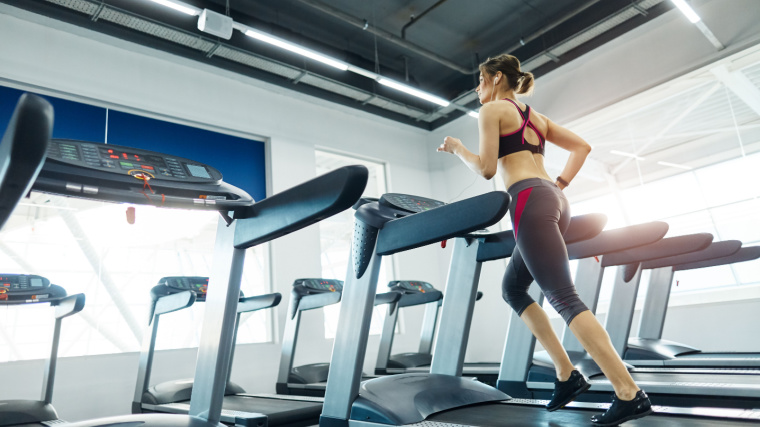[ad_1]
High-intensity interval training (or HIIT) is a style of cardio that athletes either love, hate, or (somehow) both at once. From aerobics classes to long-distance nature walks, there’s no shortage of options for burning calories or working on your health. But HIIT takes things to a brand new level of intensity and turns your walk into a series of hard sprints toward gains.
While there are nearly infinite ways to do HIIT — from box jumps and burpees to kettlebell exercises and thrusters — sometimes, you’ll literally be sprinting. You can run anywhere you have the space. But to get in an amazing set of all-out sprints without hitting the track or trails, the treadmill comes in clutch.

This quintessential cardio machine helps with climate control and pacing, giving you the ability to map out your duration, distance, and speed. All you need is a treadmill and a whole lot of grit.
When you’re ready to pick up the pace, here are the five best HIIT treadmill workouts.
Best Treadmill HIIT Workouts
Classic Treadmill HIIT
One very prominent HIIT protocol is the classic 4×4. You’ll move through four-minute work intervals with three-minute rest times. The goal is to perform high-effort intervals, absolutely cranking your heart rate before reducing your pace to something more modest for the rest phase. Technically, these work intervals are longer than traditional HIIT sessions call for. Still, you’ll absolutely feel the intensity.
When compared to more moderate-intensity cardio, such as steady-state, low-intensity (LISS) cardio, the 4×4 regimen has shown greater improvements in maximum oxygen uptake (VO2 max). (1) That type of impact on your body — combined with the high heart rate you’ll be creating — is why this type of workout is colloquially considered HIIT.
The Workout
The classic 4×4 regimen is exactly as advertised. After a moderate-intensity warm-up phase, you perform four 4-minute bursts of higher-intensity intervals. The goal is to get your heart rate between 85 to 95 percent of your heart rate maximum (HRMax). You then reduce your pace to a speed that holds your heart rate at 70 percent HRMax for three minutes of recovery.
[Read More: Elliptical vs. Treadmill: Which Cardio Machine Is Best for You?]
You can estimate your max heart rate by subtracting your age from 220, then use either treadmill sensors, a heart rate monitor, or a fitness tracker to gauge how you’re doing.
- 10-minute warm-up at approximately 60% HRMax
- 4 minutes at 85%-95% HRMax
- 3 minutes at 70% HRMax
- Repeat the above intervals for 4 total rounds
- 5-minute cool-down at 50% HRMax
HIIT Circuit
Whether you’re in a CrossFit box calling it a WOD (workout of the day) or are a powerlifter challenging yourself and your gym buddy to battle through a tough workout finisher, HIIT circuits are a great tool. They involve cycling through a few different exercises in a row, then repeating for a few rounds.

[Read More: The 7 Treadmill Benefits You Need To Know About]
Instead of compartmentalizing resistance training and cardio, HIIT circuits weave them together into one highly effective workout.
The Workout
This HIIT workout involves combining classic strength exercises with a short run. Here, you won’t be all-out sprinting. Instead, the run will actually serve as something of a recovery period from your deadlifts. Run a steady, challenging pace without actually doing an all-out sprint. For the deadlift, choose a weight that’s manageable but challenging for 12 to 15 reps in a set.
- Deadlift: 1 x 10
- Push-Up: 1 x 10
- 200-Meter Treadmill Run
- Repeat circuit for five to six rounds, resting as little as possible. Record your total time.
Sprint Interval Training
Many in strength sports spaces define HIIT as an all-out effort — so intense that you physically can’t sustain it for more than 10 seconds. This dramatically narrows down what one may consider “true” HIIT. In that sense, sprint training featuring 10-second all-out, max-effort sprints is perhaps the truest form of HIIT.
This type of all-out sprint workout is not for the faint of heart. With that in mind, you’ll want to be very diligent with warming up and cooling down. In this extremely condensed period, you’ll be asking your heart (and body) to perform highly rigorous activity. Make sure you are adequately warmed up before getting after it.
The Workout
Unless you have a self-powered treadmill at your disposal, you’ll have to contend with the treadmill building up to your top speed. If you have a lot of experience with treadmills and feel confident at using the treadmill’s arms and a quick hop to straddle your feet onto the still sides of the belt, you can simply rest instead of walking during your recovery time. Then, you’ll hop back to top speed immediately for your max effort bursts.
Alternatively, use the last few seconds of your recovery time to power the treadmill up to your max speed. Once the treadmill indicates that you’ve reached it, start counting your 10 seconds from there. Consider extending your recovery a few seconds to compensate for the build-up and come-down time the belt takes between sprints.
- 10-minute warm-up at approximately 60% HRMax
- 10 seconds at a maximal sprint
- 50 seconds to 1 minute and 40 seconds of active rest (walking)
- Repeat the above intervals for 5 to 10 total rounds
- 10-minute cool-down at 50% HRMax
High Incline Run
Not every HIIT treadmill workout looks the same. While the first thing to pop into your mind is likely an all-out sprint, the real target is your heart rate. Not every HIIT workout needs to be a trailblazing straight line. Take advantage of everything a treadmill has to offer and you’ll be able to create the right stimulus.
[Read More: 30-Minute Treadmill Workouts to Build Stamina and Strength]
Hitting a high-incline run elicits the same peaked heart rate that a low-to-no incline max sprint achieves. The incline on your treadmill challenges your lower body in a different way, but the heart rate peaks all the same. Be sure to practice for a bit to avoid tripping while running uphill!
The Workout
Much like your sprint interval training, taking advantage of a pre-set work-to-rest ratio works wonders. Go into your workout with a plan, aiming for 30 seconds of work followed by 1.5 to two minutes of rest. Moderate interval lengths should be followed by a moderate rest period, aim for a 1:3 to 1:4 work-to-rest ratio here.
- 10-minute warm-up at approximately 60% HRMax
- 30-seconds at a moderate run on a high incline
- 1.5 to 2 minutes of slow uphill walking
- Repeat the above intervals for 5 to 10 total rounds
- 5-minute cool-down at 50% HRMax
Beginner HIIT
Not all treadmill HIIT workouts are made the same. You should always scale your resistance training workouts to meet your experience level — and HIIT workouts are no different. If you are just getting started, a sprint interval session might not be your best option.

[Read More: Stairmaster Vs. Treadmill — Which One Should You Use for Cardio, Strength, and More?]
Meet yourself where you are at. The shape of the workout is less important than what is happening to your heart rate. If you are a beginner, something as straightforward as an incline walk is sufficient to accomplish what HIIT is aiming to do — challenge you to your personalized max effort.
The Workout
As a beginner, don’t sweat it if you’re not able to do full-out running or sprints. Instead, take advantage of the incline a treadmill provides. Choosing a brisk high-incline walk might be just right to peak your heart rate.
- 10-minute warm-up at approximately 60% HRMax
- 1-minute at a moderate-paced walk at maximum incline
- 2 to 3 minutes of active rest (walking)
- Repeat the above protocol for 5-10 total rounds
- 10-minute cool-down at 50% HRMax
Benefits of Treadmill HIIT Workouts
HIIT treadmill workouts are an extremely popular training option, and for good reason. They are fast-paced and keep things quite interesting. They crank your cardiovascular system all while taking barely any time at all.
Fast-Paced
A common issue with many forms of cardio is that they can be a bit…dry. Long-distance walking or even more moderately-paced jogging or running sessions can feel like you’re trapped on a hamster wheel waiting out the clock. One of the best tools for results is consistency, and keeping your workouts engaging is a huge factor here.
[Read More: Buying a Used Vs. New Treadmill — Here’s How to Know Which to Buy for Your Home Gym]
If longer cardio sessions don’t spark joy for you, the fast-paced nature of treadmill HIIT workouts may keep you motivated. Regardless of which specific HIIT workout you choose, there are always bursts of activity to prevent boredom.
Improve Cardio
The hard work you put in during treadmill HIIT workouts delivers big health gains in the form of improved cardiovascular health and fitness. HIIT workouts have been shown to improve your VO2 max, which is a common tool for estimating overall mortality risk. (1)
May Help Reduce Body Fat
If one of your goals as an athlete is to lose body fat, HIIT workouts may be able to help you out.
Losing body fat is going to be a combination of working out and a sustainable nutritional plan. And while LISS cardio and resistance training can absolutely help you add more calorie burning to your workout routine, HIIT is a time-efficient option that lets you do a lot in a very short period of time. You won’t have time to get bored, but you’ll burn plenty of calories along the way.
Programming Prowess
One of the hidden gem benefits of treadmill HIIT workouts is that they are very program-friendly. While the majority of your time and effort is likely spent in the weight room, spicing in some cardio is good for just about everybody. The problem is finding the time to do so.
Treadmill HIIT workouts are extremely easy to weave into your programming. They’re easily completed on their own day or even tucked at the end of a strength or bodybuilding-style workout. The compact nature of treadmill HIIT workouts makes them as non-invasive as possible on your time in the gym.
Treadmill HIIT Warm-Up
Warming up for any workout is an important component of success. Either by priming movement patterns to groove your work sets or simply stretching out to relieve tightness, a specific dynamic warm-up for your needs is paramount.
Treadmill HIIT warm-ups are a good idea, as well. Although there may be minimal resistance training aspects here, you’ll still be explosively calling on your lower body to power through the intervals. You’ll want your heart to be ready for action, too.
[Read More: Running on a Treadmill Vs. Running Outside — Which Is Best for Your Goals?]
Thankfully, treadmill HIIT warm-ups are fairly straightforward. Scale each warm-up to your needs, but as a general rule, lighter-intensity treadmill work should suffice. Tack on some specific stretches or foam rolling techniques as needed and you should be set.
Here is a quick example of a treadmill HIIT warm-up routine.
The above warm-up should take approximately five minutes. From there, get more specific by performing five to 10 minutes of moderate-intensity treadmill walking or jogging. You’re now all set for your treadmill HIIT workout.
How to Program Treadmill HIIT Workouts
Programming your treadmill HIIT workouts is as simple as managing a few key points. Make sure you’re prioritizing all of your training goals, make time for recovery, and don’t overdo the frequency.
Timing Is Everything
Adding in intensive cardio training of any variety is a potential wrench in your program — unless you prioritize your goals. If your main focus is improving your cardio game, you should place it on its own day or at the beginning of your workout routine.

[Read More: The Best Treadmill Workouts, Regardless of Your Experience Level]
If you’re looking to make some improvements to your cardio, manage calories, or anything in between but still have your main goals in muscle hypertrophy and increasing strength, that’s another story. Place your treadmill HIIT workouts at the end of your session, or again, on its own day. That way, you can give your full energy to getting stronger under the barbell — your main goal — and use your remaining energy for supplemental HIIT.
Recovery Is Key
Recovery from any workout is key for realizing the gains you’re chasing. Treadmill HIIT workouts are rigorous, so sleep, nutrition, and overall recovery are very important.
Getting adequate sleep, proper intake of carbs, protein, and fat, and making sure you leave enough time between sessions is huge for your results.
Don’t Overdo It
Treadmill HIIT workouts are highly intense. As indicated by the name, high-intensity interval training reduces the overall time or volume of your workouts by cranking up the intensity. One of the major benefits of treadmill HIIT workouts is that you don’t need many of them to make gains.
Particularly as you improve and the performance on your sprints gets better, you’ll need to spread your treadmill HIIT workouts out. Take a day or two off between sessions, and limit yourself to about two to three of these per week to allow yourself adequate recovery time.
Shred the Tread
HIIT workouts are all the rage. They condense your cardio workouts into smaller bite-sized (high-intensity) pockets, without sacrificing heart benefits or any calorie-burning goals. Treadmills are widely accessible options and weave seamlessly into many HIIT protocols. There are even some that are best performed on a treadmill, such as incline workouts.
Whether you’re a beginner or aiming to sprint interval-style, the treadmill has you covered. Be sure to allow for adequate recovery and be careful not to over-program your HIIT treadmill workouts. Nail down these protocols and you’ll secure some much-sought-after health and fitness gains.
References
- Acala, J. J., Roche-Willis, D., & Astorino, T. A. (2020). Characterizing the Heart Rate Response to the 4 × 4 Interval Exercise Protocol. International journal of environmental research and public health, 17(14), 5103.
Featured Image: Gorodenkoff / Shutterstock
[ad_2]
Source link


